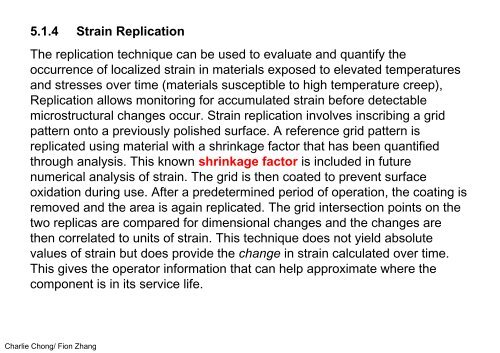ASNT Level III- Visual & Optical Testing
My Level III Self Study Notes Reading 4 Section 4B
My Level III Self Study Notes Reading 4 Section 4B
You also want an ePaper? Increase the reach of your titles
YUMPU automatically turns print PDFs into web optimized ePapers that Google loves.
5.1.4 Strain Replication<br />
The replication technique can be used to evaluate and quantify the<br />
occurrence of localized strain in materials exposed to elevated temperatures<br />
and stresses over time (materials susceptible to high temperature creep),<br />
Replication allows monitoring for accumulated strain before detectable<br />
microstructural changes occur. Strain replication involves inscribing a grid<br />
pattern onto a previously polished surface. A reference grid pattern is<br />
replicated using material with a shrinkage factor that has been quantified<br />
through analysis. This known shrinkage factor is included in future<br />
numerical analysis of strain. The grid is then coated to prevent surface<br />
oxidation during use. After a predetermined period of operation, the coating is<br />
removed and the area is again replicated. The grid intersection points on the<br />
two replicas are compared for dimensional changes and the changes are<br />
then correlated to units of strain. This technique does not yield absolute<br />
values of strain but does provide the change in strain calculated over time.<br />
This gives the operator information that can help approximate where the<br />
component is in its service life.<br />
Charlie Chong/ Fion Zhang


















